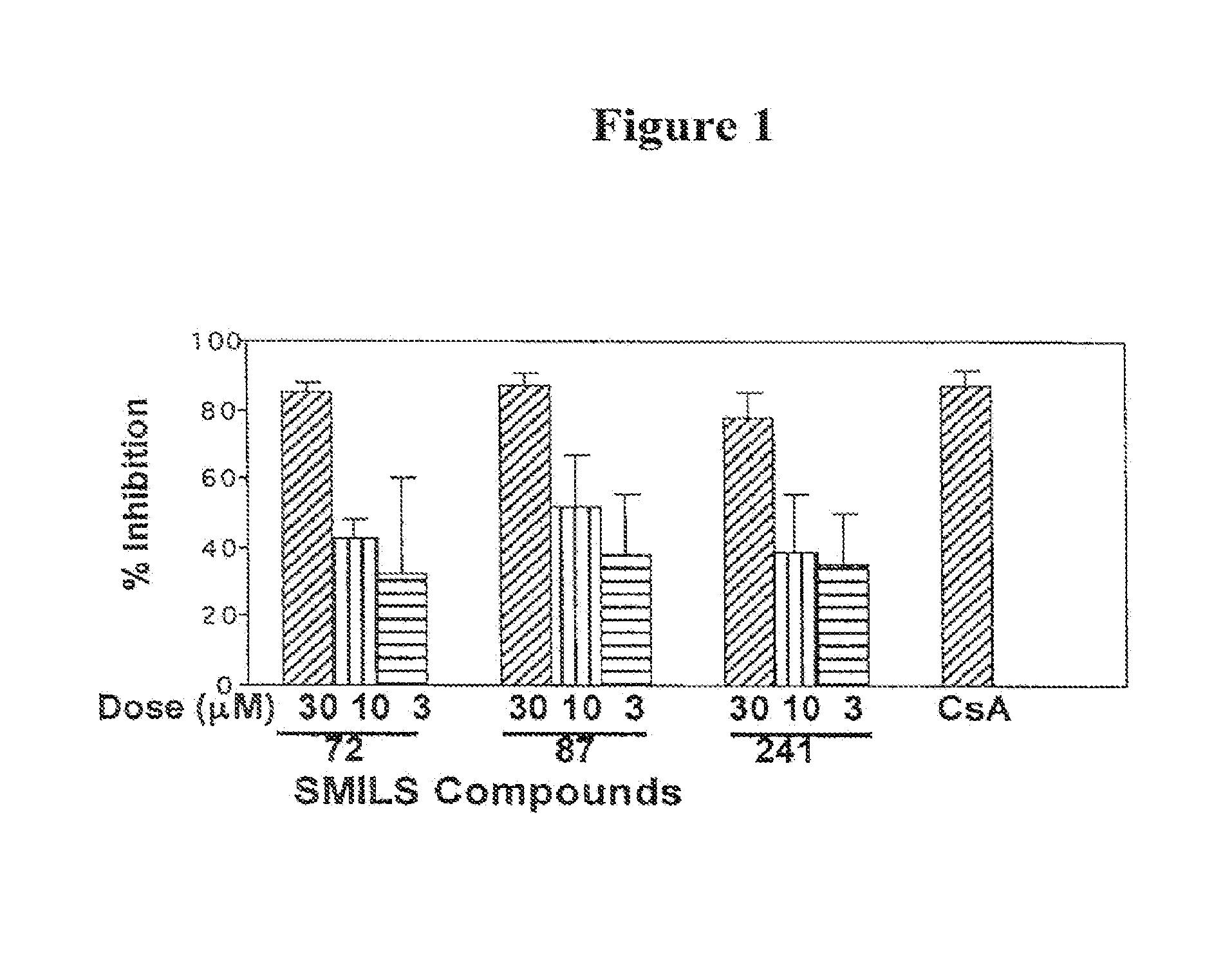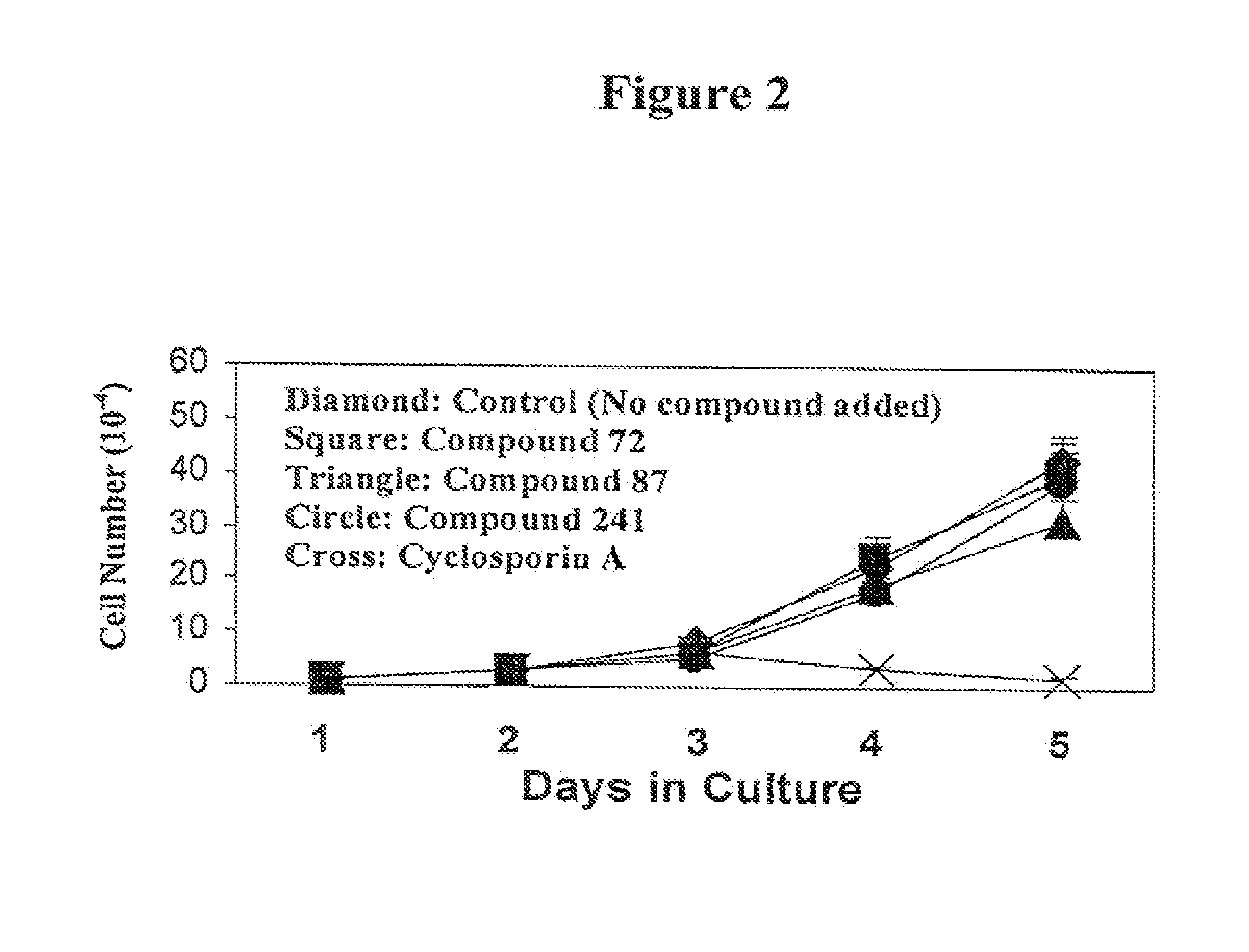Small molecule inhibitors of lck sh2 domain binding
a small molecule inhibitor and domain technology, applied in the field of small molecule inhibitors of lck sh2 domain binding, can solve the problems of unsuitable for further drug development, lack of desired specificities, and inability to target the target protein, and achieve the effect of suppressing an undesired immune respons
- Summary
- Abstract
- Description
- Claims
- Application Information
AI Technical Summary
Benefits of technology
Problems solved by technology
Method used
Image
Examples
example 1
Identification of SMILS that Blocks Lck SH2 Domain Association with the CD3 ζ Chain pY-ITAM
[0052]Compounds have been identified that inhibited Lck SH2 domain binding to the CD3 ζ chain ITAM peptide using a combination of CADD and biological assays using a solid phase EIA assay developed in our laboratory. Using this screening 42 out of 190 test compounds inhibited the ITAM binding of Lck SH2 domains by more than 60% at 100 μM concentration (data not shown).
[0053]Lck kinase is a member of Src family kinases including Fyn, Lyn, and Hck that have SH2 domains sharing significant sequence homologies at βD5, βE4, EF1 and βG4 sites where these amino acids form the pY+3 binding pocket. Accordingly, it was important to test inhibition specificities of compounds against SH2 domains of these Src kinases and other signal transduction molecules involved in TCR proximal signaling. All 42 compounds identified in the above assay were subjected to specificity screening using a solid phase EIA assay ...
example 2
Inhibition of Mixed Lymphocyte Reaction
[0056]The identified 3 specific SMELS were first tested for their ability to inhibit mixed lymphocyte reaction (MLR), a common assay to assess allogeneic responses of T cells in vitro. Lymph node lymphocyte single cell suspensions from C3H and CD-1 mice (5×105 cells from each strain) were cultured for 72 h in 200 μl of culture medium in the presence or absence of the test compounds. As shown in FIG. 1, T cell proliferation in response to allogeneic stimulation was inhibited in a dose-dependent manner by the compounds. At 30 μM, the rate of inhibition was equivalent to 1 μM cyclosporin A (CsA). Compounds inhibited MLR using lymphocytes from Lewis and Wister rats equally well.
example 3
Cytotoxicity Test
[0057]None of the compounds tested showed any cytotoxicity in Jurkat cell growth assay. Compounds 72 and 241 had no effect on cell growth whereas 87 appears to have had a slight cytostatic effect. In contrast, the addition of 1 μM CsA to the culture completely killed Jurkat cells (FIG. 2). Moreover in the MLR assays, the viability of the cells that received compound was similar to that of control cultures. These results indicate that the selected compounds did not have cytotoxic effects in vitro.
PUM
| Property | Measurement | Unit |
|---|---|---|
| body weight | aaaaa | aaaaa |
| time | aaaaa | aaaaa |
| time | aaaaa | aaaaa |
Abstract
Description
Claims
Application Information
 Login to View More
Login to View More - R&D
- Intellectual Property
- Life Sciences
- Materials
- Tech Scout
- Unparalleled Data Quality
- Higher Quality Content
- 60% Fewer Hallucinations
Browse by: Latest US Patents, China's latest patents, Technical Efficacy Thesaurus, Application Domain, Technology Topic, Popular Technical Reports.
© 2025 PatSnap. All rights reserved.Legal|Privacy policy|Modern Slavery Act Transparency Statement|Sitemap|About US| Contact US: help@patsnap.com



